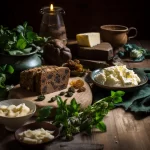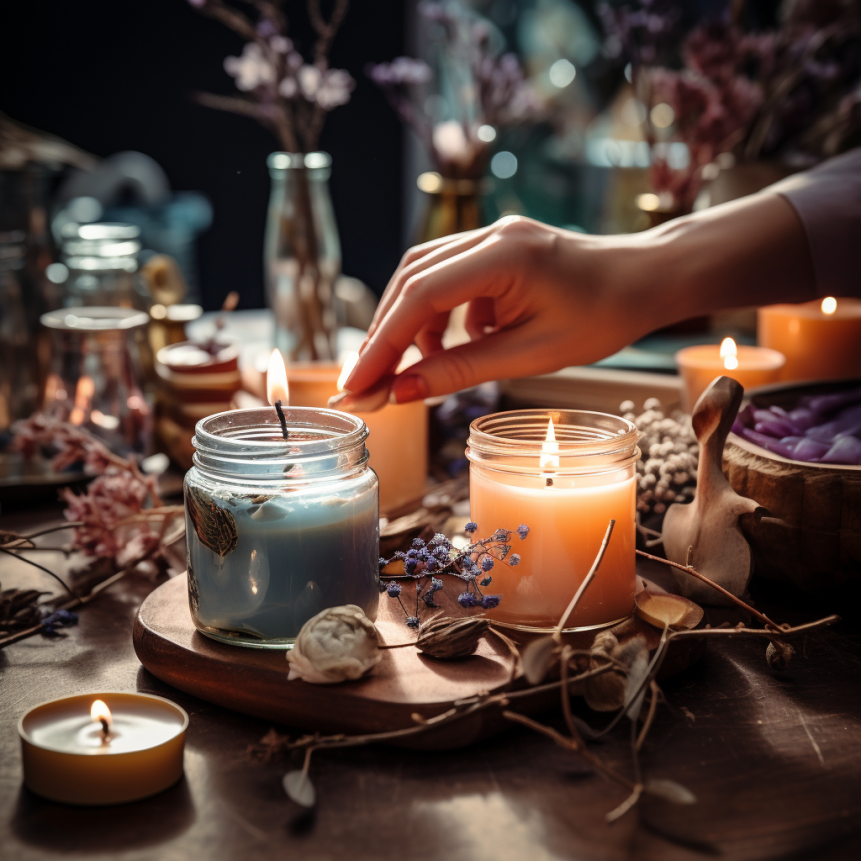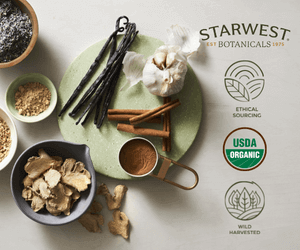Imbolc, also known as Brigid’s Day, is a traditional Gaelic festival marking the beginning of spring. Celebrated around February 1st or 2nd, it symbolizes the halfway point between the winter solstice and the spring equinox.
Related Articles
Historical significance
Historically, Imbolc has been a significant event for the ancient Celts, who observed it as a pivotal time when the earth starts to awaken from its winter slumber, heralding the return of life and fertility. Similarly, celebrating yule marks the winter solstice and the return of light, underscoring the cyclical nature of seasonal festivals. Both festivals emphasize the importance of light and renewal, connecting us deeply with the rhythms of nature.
Importance in modern times
In modern times, Imbolc retains its importance as a chance to embrace new aspirations, cleanse our spaces, and prepare for the year ahead.

Understanding Imbolc
Origins of the festival
Imbolc has roots in pagan traditions, specifically tied to the worship of the goddess Brigid, who embodies healing, poetry, and smithcraft.
Connection to Celtic culture
Within Celtic culture, Imbolc is intrinsically linked to the agricultural calendar, as it signals the time for farmers to begin preparations for their spring crops.
Imbolc as a seasonal festival
The festival ushers in the seasonal transition from dark winter days to the promise of brighter, warmer times.
Association with Saint Brigid
The Christian era saw the adaptation of this pagan festival into the Feast of Saint Brigid, a patron saint of Ireland, thus merging ancient customs with Christian traditions.

Preparing for Imbolc
Preparations are key to fully experiencing and embracing the essence of Imbolc.
Setting intentions for the festival
Spend time reflecting on your aspirations and goals for the coming season. Intentions should spring from personal desire for growth in various aspects of your life. Just as the moon phases magick guide us through cycles of growth and reflection, setting intentions during Imbolc can help align your personal goals with the natural rhythms of the earth.
Cleaning and decluttering your space
A clean physical space reflects a clear mental space. Engage in a thorough cleansing and decluttering of your home to invite fresh energies.
Gathering necessary supplies
Collect items essential to your celebration—candles, natural elements, crafting materials, and the ingredients for your Imbolc recipes.
Creating a Sacred Space
Create a sacred space that resonates with the energy of Imbolc—a temple of tranquility within your own dwelling.
Choosing the right location
Find a spot in your home that feels peaceful. It can be a small corner or an entire room dedicated to this festival.
Decorating your space with symbols of Imbolc
Adorn your sacred space with Imbolc decorations such as white flowers, crystals, and representations of Brigid.
Incorporating the four elements
Balancing the earth, air, fire, and water within your space can be done through natural objects like stones, feathers, candles, and bowls of water to represent each element.
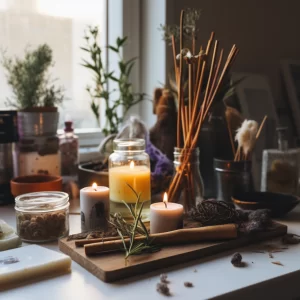
Imbolc Rituals and Traditions
Multiple rituals and traditions can be included in your celebration to enrich your experience of Imbolc.
Lighting candles for light and warmth
Illuminating your space with candles is a traditional method to honor the returning sunlight and bring warmth to the spirit.
Making Brigid’s crosses
Crafting a Brigid’s cross from reeds or straw is a profound way to invite protection and blessings into your home.
In the Southwest desert, particularly in an area like Phoenix, AZ, where traditional reed or straw may not be readily available, you can look to native desert plants for crafting materials. For making a Brigid’s Cross, which traditionally uses rushes, a suitable desert plant replacement could be Beargrass (Nolina microcarpa). Beargrass has long, flexible leaves that can be used similarly to rushes or straw when dried.
Here’s a simple guide on how to prepare Beargrass for crafting a Brigid’s Cross:
- Harvesting: Collect Beagrass leaves, ensuring that you are doing so sustainably and with respect for the environment.
- Drying: Allow the leaves to dry until they are flexible but not brittle. This may take a few days depending on the climate.
- Soaking: If the leaves are too stiff, you can soak them in water to increase pliability.
- Crafting: Use the leaves to craft your Brigid’s Cross by folding and weaving them as you would with traditional rushes.
The practice of “Brigid’s Bed”
Creating a small bed with a corn doll and inviting Brigid’s spirit to rest signifies the nurturing of our internal seeds, which will bloom in the coming months.
As we’ve begun to explore, Imbolc is a time of significance and beauty, offering a multitude of ways to celebrate and align with nature’s rhythm. By understanding its history, setting focused intentions, and creating the right environment, you’re laying the groundwork for a truly transformative Imbolc celebration.
Creating an Imbolc Altar
An altar acts as a focal point for your Imbolc celebrations. It’s a physical manifestation of your intentions and a sacred space for Imbolc spells and meditations. To create your Imbolc altar setup, consider incorporating the following:
– Elements of nature: Evergreens, stones, or flowers like snowdrops, which are among the first blooms of the year.
– Symbols of Brigid: Brigid’s crosses, Brigid dolls, or representations of her sacred flame.
– Candles: White candles are standard, signifying purity and the return of light.
– Seasonal Offering: A bowl of milk and honey to honor the fertility of the earth.
When setting up your altar, it is important to do so with intention and reverence. Your altar will become the spiritual heart of your Imbolc celebration.
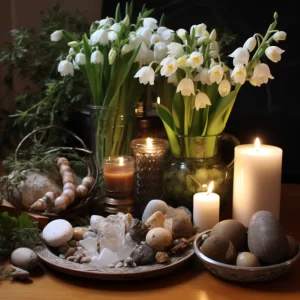
These Imbolc crafts not only pay homage to the festival’s traditions but also bring a personal touch to your observance. Crafting can be a solace, a ritual, and a way to express creativity and spirituality.
Honoring Nature and the Coming of Spring
Imbolc, marking the initial stirrings of spring, is intrinsically linked with nature’s rejuvenation. This is the time to step outside, engage with the living earth, and prepare for the growth that spring promises. Here are meaningful Imbolc activities to celebrate the natural world.
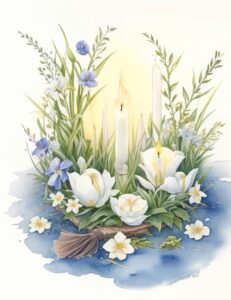
Planting Seeds or Bulbs
As Imbolc signifies the awakening of the land, planting seeds or bulbs is a symbolic act of participation in nature’s cycle. It’s also an opportunity to practice Imbolc rituals rooted in earth’s fertility. Consider:
– Choosing seasonal seeds or bulbs that resonate with Imbolc, such as snowdrops or crocuses, known for their early bloom.
– Engaging in a meditative seed planting ritual. With each seed, set an intention for personal growth in harmony with nature’s own burgeoning life.
– Incorporating biodegradable seed paper into your Imbolc crafts, sowing them afterward as a sustainable way to connect your crafting to the land.
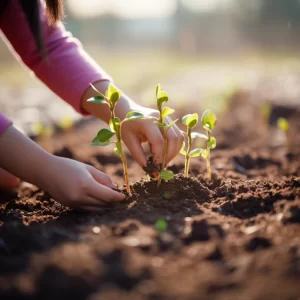
Planting is more than putting seeds in the soil; it’s a commitment to nurture, witness, and partake in life’s unfolding. This is akin to growing an herbal tea garden, where each plant is tended with care and intention, ultimately providing a bountiful harvest that nourishes both body and spirit.
Nature Walks to Observe Early Signs of Spring
Step outside for an Imbolc nature walk, with eyes and heart open to the earliest whispers of spring:
– Listen and look for returning birds, budding plants, and the softening of earth beneath your feet.
– Collect natural items with respect, perhaps to adorn your Imbolc altar or to use in Imbolc nature crafts.
– Take a meditative walk, allowing the peace of the natural world to infuse your spirit with calm and clarity.
Observing the subtle changes invites a deeper connection with the rhythms of the earth and encourages mindfulness of the environment’s fragile beauty.
Reflecting and Looking Ahead
As we draw near the close of our Imbolc celebration, it is essential to look inward, to reflect upon the personal revelations experienced, and to set forth a path for the times to come. Imbolc is not only an observance of seasonal change but is also a beacon for inner renewal and foresight.
Journaling and Self-reflection
In the tranquility following your Imbolc rituals and festivities, carve out a space for quiet contemplation. Journaling is an excellent tool for this purpose:
– Reflect upon the Imbolc symbolism and its relevance to your life. How do themes of purification, light, and growth speak to you?
– Use Imbolc journaling prompts to excavate inner wisdom, such as “What seeds of intention am I planting this Imbolc?” or “In what ways can I nurture my well-being as the Earth nurtures new life?”
– Engage in Imbolc dream journaling, noting any significant dreams you have around the time of the festival that might offer insights or inspiration.
This practice of self-reflection allows you to integrate the lessons and energy of Imbolc into your personal journey.
Making Resolutions and Setting Goals
Just as the Earth begins to stir with life, use Imbolc as a time to establish resolutions and goals: Creating a vision board can be a powerful tool in this process. Consider exploring witchy vision board ideas to manifest your intentions and bring your goals to life. This practice not only clarifies your aspirations but also channels your creative energy into a tangible form.
– Consider the areas of your life you wish to rejuvenate, just as the land is rejuvenated at Imbolc.
– Set practical and achievable goals, pairing them with intentions to infuse them with deeper meaning.
– Conduct a goal-setting ritual, perhaps writing your goals on paper and planting them with a seed, symbolizing the growth you wish to see.
With these resolutions, you align your will with the energizing force of the season, embarking on a cycle of fulfillment and accomplishment.
Closing Thoughts and the Significance of Carrying Imbolc’s Light Forward
As we bid farewell to Imbolc and embrace the impending spring, let us consider how we can carry the festival’s light throughout the remainder of the year:
– Hold onto the clarity and sense of purpose cultivated during this time.
– Act upon the intentions you have set forth, remembering that each step you take is sowing seeds for future harvests, both metaphorically and literally.
– Keep the spirit of community, conservation, and creativity alive in your heart, understanding that these are not limited to the festival but are practices to be integrated into daily life.
The light of Imbolc does not dim with the festival’s end; instead, it becomes a perpetual flame within us—a guiding force that illuminates our path forward.
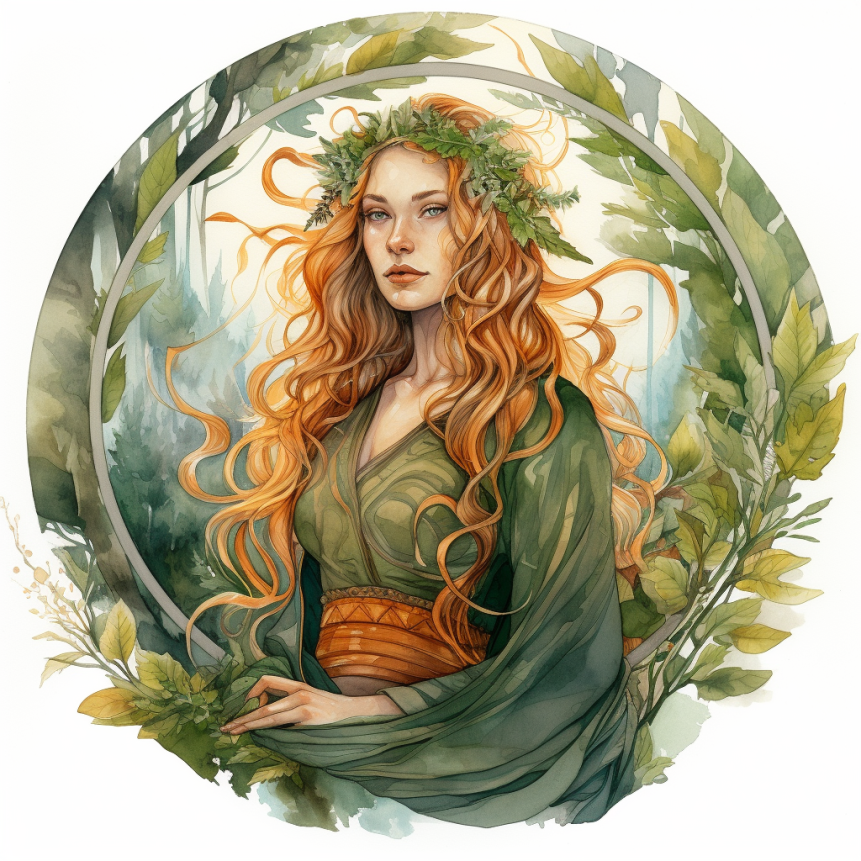
Frequently Asked Questions
Imbolc is a traditional Gaelic festival marking the beginning of spring, typically celebrated on February 1st.
Start by cleaning your home, setting up an altar with symbols of spring, and planning a personal ritual or community gathering.
Light candles or a bonfire to represent the return of warmth. Engage in crafting activities like weaving Brigid’s crosses from reeds or straw.
Brigid is a Celtic goddess associated with healing, poetry, and smithcraft. She symbolizes new beginnings and fertility, making her central to Imbolc celebrations
Yes! Foods like dairy products, seeds such as sunflower or pumpkin seeds, and spiced wines are traditional for an Imbolc feast.
Organize or attend local gatherings that may include feasts, storytelling sessions about Brigid, or group nature walks to observe signs of early spring.
Nature’s awakening is at the heart of Imbolc. Celebrate by taking a hike to see early buds or having a picnic outdoors if weather permits.

